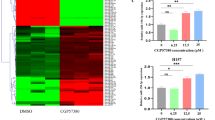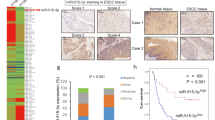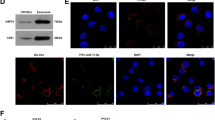Abstract
Analysis of our microRNA (miRNA) expression signatures of human cancers based on RNA sequencing have shown that both strands of pre-miR-150, miR-150-5p (the guide strand) and miR-150-3p (the passenger strand), are significantly reduced in cancer tissues. We have investigated the functional significance of both strands of pre-miR-150 in cancer cells. The aim of this study was to investigate the antitumor function of these miRNAs and how these miRNAs regulated oncogenic targets in esophageal squamous cell carcinoma (ESCC). Ectopic expression studies demonstrated that both strands of pre-miR-150 miRNA inhibited ESCC cancer cell migration and invasion, indicating that both miR-150-5p and miR-150-3p acted as antitumor miRNAs. A combination of genome-wide gene expression analyses and in silico database searches showed that SPOCK1 (SPARC/osteonectin, cwcv and kazal-like domains proteoglycan 1) was a candidate target of miR-150-5p and miR-150-3p in ESCC cells. Luciferase reporter assays showed that SPOCK1 was directly regulated by these miRNAs. Silencing of SPOCK1 by small interfering RNA inhibited cancer cell migration and invasion. Overexpression of SPOCK1/SPOCK1 was confirmed by real-time PCR methods and immunohistochemistry. Taken together, downregulation of both strands of pre-miR-150 and overexpression of SPOCK1 are involved in ESCC pathogenesis. The involvement of passenger strand miRNAs in the regulation of cancer cell aggressiveness is a novel concept in RNA research.
Similar content being viewed by others
Log in or create a free account to read this content
Gain free access to this article, as well as selected content from this journal and more on nature.com
or
References
Ferlay, J., Soerjomataram, I., Dikshit, R., Eser, S., Mathers, C., Rebelo, M. et al. Cancer incidence and mortality worldwide: sources, methods and major patterns in GLOBOCAN 2012. Int. J. Cancer 136, E359–E386 (2015).
Hori, M. M. T., Shibata, A., Katanoda, K., Sobue, T., Nishimoto, H. et al. Cancer incidence and incidence rates in Japan in 2012: a study of 32 population-based cancer registries for the Monitoring of Cancer Incidence in Japan (MCIJ) project. Jpn J. Clin. Oncol. 45, 884–891 (2016).
Pennathur, A., Gibson, M. K., Jobe, B. A. & Luketich, J. D. Oesophageal carcinoma. Lancet 381, 400–412 (2013).
Enzinger, P. C. & Mayer, R. J. Esophageal cancer. N. Engl. J. Med. 349, 2241–2252 (2003).
Ohashi, S., Miyamoto, S., Kikuchi, O., Goto, T., Amanuma, Y. & Muto, M. Recent advances from basic and clinical studies of esophageal squamous cell carcinoma. Gastroenterology 149, 1700–1715 (2015).
Hongo, M., Nagasaki, Y. & Shoji, T. Epidemiology of esophageal cancer: orient to occident. Effects of chronology, geography and ethnicity. J. Gastroenterol. Hepatol. 24, 729–735 (2009).
Bartel, D. P. MicroRNAs: genomics, biogenesis, mechanism, and function. Cell 116, 281–297 (2004).
Friedman, R. C., Farh, K. K., Burge, C. B. & Bartel, D. P. Most mammalian mRNAs are conserved targets of microRNAs. Genome Res. 19, 92–105 (2009).
Bartel, D. P. MicroRNAs: target recognition and regulatory functions. Cell 136, 215–233 (2009).
Isozaki, Y., Hoshino, I., Nohata, N., Kinoshita, T., Akutsu, Y., Hanari, N. et al. Identification of novel molecular targets regulated by tumor suppressive miR-375 induced by histone acetylation in esophageal squamous cell carcinoma. Int. J. Oncol. 41, 985–994 (2012).
Osako, Y., Seki, N., Kita, Y., Yonemori, K., Koshizuka, K., Kurozumi, A. et al. Regulation of MMP13 by antitumor microRNA-375 markedly inhibits cancer cell migration and invasion in esophageal squamous cell carcinoma. Int. J. Oncol. 49, 2255–2264 (2016).
Harada, K., Baba, Y., Ishimoto, T., Shigaki, H., Kosumi, K., Yoshida, N. et al. The role of microRNA in esophageal squamous cell carcinoma. J. Gastroenterol. 51, 520–530 (2016).
Kikkawa, N., Hanazawa, T., Fujimura, L., Nohata, N., Suzuki, H., Chazono, H. et al. miR-489 is a tumour-suppressive miRNA target PTPN11 in hypopharyngeal squamous cell carcinoma (HSCC). Br. J. Cancer 103, 877–884 (2010).
Nohata, N., Hanazawa, T., Kikkawa, N., Sakurai, D., Fujimura, L., Chiyomaru, T. et al. Tumour suppressive microRNA-874 regulates novel cancer networks in maxillary sinus squamous cell carcinoma. Br. J. Cancer 105, 833–841 (2011).
Itesako, T., Seki, N., Yoshino, H., Chiyomaru, T., Yamasaki, T., Hidaka, H. et al. The microRNA expression signature of bladder cancer by deep sequencing: the functional significance of the miR-195/497 cluster. PLoS ONE 9, e84311 (2014).
Fukumoto, I., Hanazawa, T., Kinoshita, T., Kikkawa, N., Koshizuka, K., Goto, Y. et al. MicroRNA expression signature of oral squamous cell carcinoma: functional role of microRNA-26a/b in the modulation of novel cancer pathways. Br. J. Cancer 112, 891–900 (2015).
Matsushita, R., Seki, N., Chiyomaru, T., Inoguchi, S., Ishihara, T., Goto, Y. et al. Tumour-suppressive microRNA-144-5p directly targets CCNE1/2 as potential prognostic markers in bladder cancer. Br. J. Cancer 113, 282–289 (2015).
Matsushita, R., Yoshino, H., Enokida, H., Goto, Y., Miyamoto, K., Yonemori, M. et al. Regulation of UHRF1 by dual-strand tumor-suppressor microRNA-145 (miR-145-5p and miR-145-3p): inhibition of bladder cancer cell aggressiveness. Oncotarget 7, 28460–28487 (2016).
Mataki, H., Seki, N., Mizuno, K., Nohata, N., Kamikawaji, K., Kumamoto, T. et al. Dual-strand tumor-suppressor microRNA-145 (miR-145-5p and miR-145-3p) coordinately targeted MTDH in lung squamous cell carcinoma. Oncotarget 7, 72084–72098 (2016).
Koshizuka, K., Nohata, N., Hanazawa, T., Kikkawa, N., Arai, T., Okato, A. et al. Deep sequencing-based microRNA expression signatures in head and neck squamous cell carcinoma: dual strands of pre-miR-150 as antitumor miRNAs. Oncotarget 8, 30288–30304 (2017).
Kano, M., Seki, N., Kikkawa, N., Fujimura, L., Hoshino, I., Akutsu, Y. et al. miR-145, miR-133a and miR-133b: tumor-suppressive miRNAs target FSCN1 in esophageal squamous cell carcinoma. Int. J. Cancer 127, 2804–2814 (2010).
Kita, Y., Nishizono, Y., Okumura, H., Uchikado, Y., Sasaki, K., Matsumoto, M. et al. Clinical and biological impact of cyclin-dependent kinase subunit 2 in esophageal squamous cell carcinoma. Oncol. Rep. 31, 1986–1992 (2014).
Berry, M. F. Esophageal cancer: staging system and guidelines for staging and treatment. J. Thorac. Dis. 6 (Suppl 3), S289–S297 (2014).
Liu, Y., Xiong, Z., Beasley, A., D'Amico, T. & Chen, X. L. Personalized and targeted therapy of esophageal squamous cell carcinoma: an update. Ann. NY. Acad. Sci. 1381, 66–73 (2016).
Koumangoye, R. B., Andl, T., Taubenslag, K. J., Zilberman, S. T., Taylor, C. J., Loomans, H. A. et al. SOX4 interacts with EZH2 and HDAC3 to suppress microRNA-31 in invasive esophageal cancer cells. Mol. Cancer 14, 24 (2015).
Mizuno, K., Mataki, H., Arai, T., Okato, A., Kamikawaji, K., Kumamoto, T. et al. The microRNA expression signature of small cell lung cancer: tumor suppressors of miR-27a-5p and miR-34b-3p and their targeted oncogenes. J. Hum. Genet. (e-pub ahead of print 9 March 2017; doi: 10.1038/jhg.2017.27).
Goto, Y., Kojima, S., Nishikawa, R., Kurozumi, A., Kato, M., Enokida, H. et al. MicroRNA expression signature of castration-resistant prostate cancer: the microRNA-221/222 cluster functions as a tumour suppressor and disease progression marker. Br. J. Cancer 113, 1055–1065 (2015).
Li, J., Hu, L., Tian, C., Lu, F., Wu, J. & Liu, L. microRNA-150 promotes cervical cancer cell growth and survival by targeting FOXO4. BMC. Mol. Biol. 16, 24 (2015).
Qu, Y., Pan, S., Kang, M., Dong, R. & Zhao, J. MicroRNA-150 functions as a tumor suppressor in osteosarcoma by targeting IGF2BP1. Tumour Biol. 37, 5275–5284 (2015).
Yokobori, T., Suzuki, S., Tanaka, N., Inose, T., Sohda, M., Sano, A. et al. MiR-150 is associated with poor prognosis in esophageal squamous cell carcinoma via targeting the EMT inducer ZEB1. Cancer Sci. 104, 48–54 (2013).
Wang, X., Ren, Y., Wang, Z., Xiong, X., Han, S., Pan, W. et al. Down-regulation of 5 S rRNA by miR-150 and miR-383 enhances c-Myc-rpL11 interaction and inhibits proliferation of esophageal squamous carcinoma cells. FEBS Lett. 589 (Part B), 3989–3997 (2015).
Fan, L. C., Jeng, Y. M., Lu, Y. T. & Lien, H. C. SPOCK1 is a novel transforming growth factor-beta-induced myoepithelial marker that enhances invasion and correlates with poor prognosis in breast cancer. PLoS ONE 11, e0162933 (2016).
Li, Y., Chen, L., Chan, T. H., Liu, M., Kong, K. L., Qiu, J. L. et al. SPOCK1 is regulated by CHD1L and blocks apoptosis and promotes HCC cell invasiveness and metastasis in mice. Gastroenterology 144, 179–191 and 194 (2013).
Ma, L. J., Wu, W. J., Wang, Y. H., Wu, T. F., Liang, P. I., Chang, I. W. et al. SPOCK1 overexpression confers a poor prognosis in urothelial carcinoma. J. Cancer 7, 467–476 (2016).
Miao, L., Wang, Y., Xia, H., Yao, C., Cai, H. & Song, Y. SPOCK1 is a novel transforming growth factor-beta target gene that regulates lung cancer cell epithelial–mesenchymal transition. Biochem. Biophys. Res. Commun. 440, 792–797 (2013).
Song, X., Han, P., Liu, J., Wang, Y., Li, D., He, J. et al. Up-regulation of SPOCK1 induces epithelial–mesenchymal transition and promotes migration and invasion in esophageal squamous cell carcinoma. J. Mol. Histol. 46, 347–356 (2015).
Chen, Q., Yao, Y. T., Xu, H., Chen, Y. B., Gu, M., Cai, Z. K. et al. SPOCK1 promotes tumor growth and metastasis in human prostate cancer. Drug Des. Dev. Ther. 10, 2311–2321 (2016).
Acknowledgements
This study was supported by KAKENHI Grants 15K10801(C), 15K10108 and 17H04285(B). We wish to thank the Joint Research Laboratory, Kagoshima University Graduate School of Medical and Dental Sciences, for the use of their facilities.
Author information
Authors and Affiliations
Corresponding author
Ethics declarations
Competing interests
The authors declare no conflict of interest.
Additional information
Supplementary Information accompanies the paper on Journal of Human Genetics website
Supplementary information
Rights and permissions
About this article
Cite this article
Osako, Y., Seki, N., Koshizuka, K. et al. Regulation of SPOCK1 by dual strands of pre-miR-150 inhibit cancer cell migration and invasion in esophageal squamous cell carcinoma. J Hum Genet 62, 935–944 (2017). https://doi.org/10.1038/jhg.2017.69
Received:
Revised:
Accepted:
Published:
Issue date:
DOI: https://doi.org/10.1038/jhg.2017.69
This article is cited by
-
Urinary microRNA biomarkers for detecting the presence of esophageal cancer
Scientific Reports (2021)
-
Molecular pathogenesis of breast cancer: impact of miR-99a-5p and miR-99a-3p regulation on oncogenic genes
Journal of Human Genetics (2021)
-
RNA sequencing-based microRNA expression signature in esophageal squamous cell carcinoma: oncogenic targets by antitumor miR-143-5p and miR-143-3p regulation
Journal of Human Genetics (2020)
-
Regulation of aberrantly expressed SERPINH1 by antitumor miR-148a-5p inhibits cancer cell aggressiveness in gastric cancer
Journal of Human Genetics (2020)
-
Gene regulation by antitumor miR-130b-5p in pancreatic ductal adenocarcinoma: the clinical significance of oncogenic EPS8
Journal of Human Genetics (2019)



